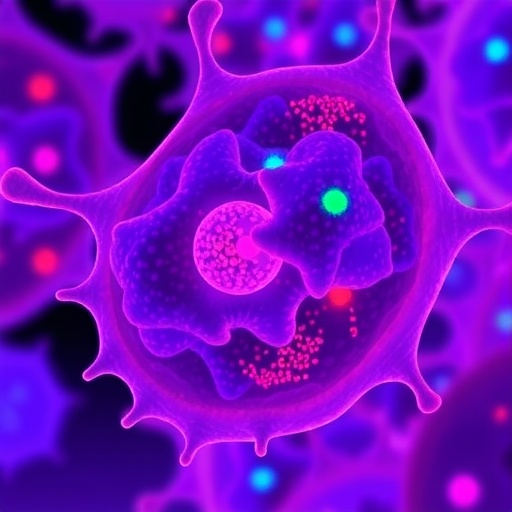In a groundbreaking study published in Nature, researchers have unraveled a crucial cellular dialogue that sustains pancreatic ductal adenocarcinoma (PDAC), one of the deadliest forms of cancer due to its notorious resistance to therapy and aggressive progression. The investigation reveals an intricate paracrine network between epithelial and mesenchymal cancer cell populations, mediated by three diffusible molecules—SPP1, BMP2, and GREM1—that collectively maintain tumor heterogeneity and promote malignancy. This discovery sheds light on the critical interplay that underpins tumor maintenance and opens promising new avenues for therapeutic intervention aimed at disrupting this interdependence.
Pancreatic cancer is characterized by a remarkable degree of cellular heterogeneity, with subpopulations of cells exhibiting distinct phenotypes and transcriptional profiles within the same tumor microenvironment. This heterogeneity has long been appreciated as a barrier to effective treatment, as different cell populations can variably respond to therapy, driving relapse and metastasis. The new study moves beyond descriptive analyses to identify the molecular crosstalk responsible for sustaining these diverse cellular states, with particular emphasis on the mesenchymal subpopulation, which is associated with invasiveness and poor prognosis.
The researchers centered their investigation on SPP1 (secreted phosphoprotein 1), a secreted glycoprotein well known for its roles in cell adhesion and migration, and increasingly linked with cancer progression. They found that SPP1 is indispensable for maintaining the mesenchymal identity of PDAC cells. Loss of SPP1 in genetically engineered mouse models led to a pronounced depletion of the mesenchymal subpopulation, impairing tumor formation and significantly extending survival. This highlights SPP1 not merely as a cancer biomarker but as a critical driver of tumor cell fate decisions.
A standout feature of the study is the demonstration that epithelial and mesenchymal PDAC cells do not exist in isolation; rather, their maintenance depends on a reciprocal, paracrine signaling loop. Specifically, the team identified BMP2, a bone morphogenetic protein known for its role in developmental pathways and cellular differentiation, and GREM1, a BMP antagonist, as key intermediaries in this crosstalk. The epithelial cells produce BMP2, which acts on mesenchymal cells, while mesenchymal cells secrete GREM1 to modulate BMP signaling. This reciprocal exchange stabilizes the coexistence of both cell types, thereby preserving the cellular heterogeneity that fuels tumor growth and resistance.
In-depth spatial transcriptomic analyses revealed that SPP1 expression is largely confined to mesenchymal compartments, underscoring its role as a niche factor maintaining this aggressive cell state. The disruption of SPP1 led to altered expression of BMP2 and GREM1, unraveling the tightly interwoven signaling circuits that create a microenvironment conducive to tumor sustenance. These findings suggest that targeting the SPP1-BMP2-GREM1 axis could effectively collapse the supportive heterogeneity within the tumor, trimming its capacity to adapt and survive.
The functional consequences of eroding the mesenchymal compartment were profound. Mouse models with Spp1 inactivation displayed a marked slowdown in tumor progression and extended lifespan compared to controls. This establishes a concrete mechanistic link between cellular heterogeneity, sustained by the SPP1-mediated paracrine loop, and pancreatic tumor aggressiveness. It also provides compelling preclinical evidence supporting the development of therapies that disrupt tumor intercellular communication, rather than focusing solely on killing bulk tumor cells indiscriminately.
Importantly, this work challenges traditional notions of cancer treatment strategies that have typically targeted tumor cells in a uniform manner. By illuminating how heterogeneity is not simply a passive byproduct but an actively maintained state through paracrine signaling, it encourages a paradigm shift. Therapeutic approaches could instead seek to dismantle the supportive networks maintaining diverse tumor cell populations, rendering the tumor less adaptable and more vulnerable to existing therapies.
Moreover, the study underscores the nuanced roles of developmental signaling pathways like BMP in cancer. While BMPs have historically been associated with differentiation and homeostasis, their hijacking within the tumor microenvironment to sustain malignant heterogeneity exemplifies their double-edged nature. GREM1’s antagonism against BMP2 within this signaling milieu further highlights a finely tuned balance exploited by the tumor to maintain diversity among cancer cells.
The translational implications of these findings are substantial. Given that therapies directly targeting the mesenchymal phenotype have been elusive, the identification of SPP1 as a linchpin molecule offers a tangible target. Future drug development may focus on inhibitors of SPP1 secretion or function, or on modulating the downstream BMP2-GREM1 axis, aiming to collapse the co-dependent epithelial-mesenchymal network so vital to PDAC’s lethality.
The research also advances our understanding of tumor ecology—the concept that cancer should be viewed as an ecosystem composed of interdependent populations rather than a collection of homogenous malignant cells. The PDAC tumor niche, as elucidated here, thrives on cellular cooperation mediated by paracrine factors. This ecological perspective brings fresh insight into metastasis, immune evasion, and therapy resistance, potentially informing combination treatments targeting multiple axes of tumor sustenance simultaneously.
While the study primarily utilizes sophisticated mouse models and molecular analyses, validating these findings in human pancreatic tumors will be essential. Given PDAC’s complex genetic and microenvironmental landscape, confirming the universality and clinical relevance of the SPP1-BMP2-GREM1 signaling network will open new horizons for personalized therapeutic approaches tailored to disrupt the tumor’s internal communication networks.
In sum, this landmark investigation surfaces a critical, previously underappreciated mechanism of intercellular cooperation in pancreatic cancer. By mapping the paracrine signals that enable epithelial and mesenchymal cells to maintain each other, it not only deepens the biological understanding of tumor heterogeneity but also delineates promising targets for disrupting the lethal resilience of PDAC. As pancreatic cancer remains one of the most challenging malignancies to treat, insights into its cellular and molecular dependencies offer a beacon of hope in the quest for better therapeutic strategies.
Subject of Research: Molecular mechanisms underlying cellular heterogeneity and paracrine signaling in pancreatic ductal adenocarcinoma.
Article Title: SPP1 is required for maintaining mesenchymal cell fate in pancreatic cancer.
Article References:
Li, H., Lan, L., Chen, H. et al. SPP1 is required for maintaining mesenchymal cell fate in pancreatic cancer. Nature (2025). https://doi.org/10.1038/s41586-025-09574-y
Image Credits: AI Generated




